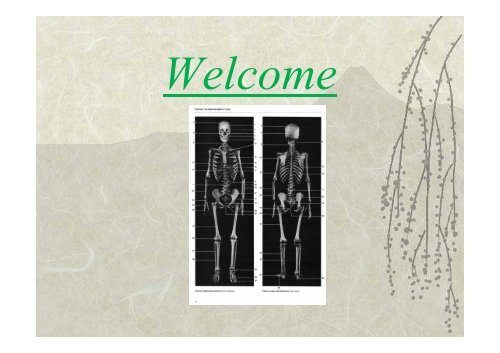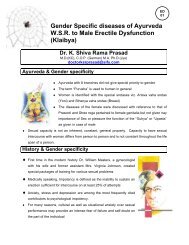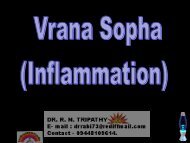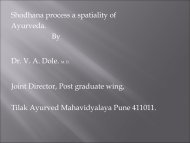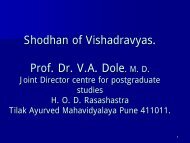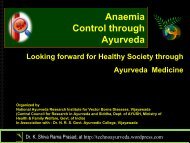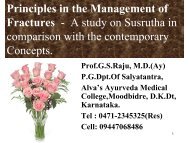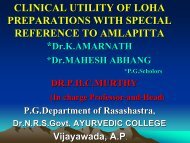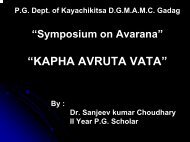Parathyroid Gland - Techno Ayurveda
Parathyroid Gland - Techno Ayurveda
Parathyroid Gland - Techno Ayurveda
You also want an ePaper? Increase the reach of your titles
YUMPU automatically turns print PDFs into web optimized ePapers that Google loves.
Welcome
The <strong>Parathyroid</strong> <strong>Gland</strong><br />
Dr. Mahesh Kundagol
<strong>Parathyroid</strong> <strong>Gland</strong> Anatomy<br />
Four <strong>Parathyroid</strong><br />
glands are usually<br />
found posterior to the<br />
thyroid gland<br />
Total weight of<br />
parathyroid tissue is<br />
about 150mg
Anatomy & Location of <strong>Parathyroid</strong> <strong>Gland</strong>
<strong>Parathyroid</strong> <strong>Gland</strong> - Overview<br />
Calcium & Phosphate Metabolism<br />
Distribution & Balance of Ca & PO 4<br />
Hormones involved<br />
– <strong>Parathyroid</strong> Hormone<br />
– Calcitonin<br />
– Vit. D<br />
Diseases associated with the <strong>Parathyroid</strong><br />
<strong>Gland</strong>
Ca 2+ Distribution & Balance
Ca 2+ Distribution & Balance cont..
PO 4- Distribution & Balance
PO 4- Distribution & Balance cont.
Bone
<strong>Parathyroid</strong> Hormone (PTH)<br />
• A peptide hormone that increases plasma<br />
Ca 2+<br />
• Causes increase in plasma Ca 2+ by:<br />
1. Mobilization of Ca 2+ from bone<br />
2. Enhancing renal reabsorption<br />
3. Increasing intestinal absorption (indirect)
Biosynthesis, Storage & Secretion of PTH<br />
PTH is synthesized as the preprohormone<br />
(Preproparathyroid Hormone) by parathyroid<br />
gland chief cells<br />
The active form of PTH is cleaved from the<br />
preprohormone before release from the gland<br />
PTH is synthesized continously (it is either<br />
released from the gland or degraded)<br />
PTH is released by exocytosis in response to<br />
reduced plasma calcium<br />
Vitamin D feeds back to reduce PTH secretion as<br />
a secondary mechanism
Regulation of PTH release by Plasma<br />
Ca 2+ Levels<br />
• PTH is released by chief cells in the<br />
parathyroid gland.<br />
• Chief cells contain receptors for Ca 2+<br />
• A decrease in plasma Ca 2+ levels mediates<br />
the release of PTH<br />
• Conversely, hypercalcemia inhibits PTH<br />
release
BONE<br />
Biological Activity of PTH<br />
– PTH stimulates bone osteoblasts to increase<br />
growth & metabolic activity<br />
– PTH stimulated bone resorption releases<br />
calcium & phosphate into blood<br />
KIDNEY<br />
– PTH increases reabsorption of calcium &<br />
reduces reabsorption of phosphate<br />
– Net effect of its action is increased calcium &<br />
reduced phosphate in plasma<br />
INTESTINE<br />
– Increases calcium reabsorption via vitamin D
Bone Growth and Calcium<br />
Metabolism<br />
Epiphyseal plate – new bone growth site<br />
Chondrocytes, osteoblasts & calcification build bone
Bone Growth and Calcium<br />
Metabolism<br />
Figure 23-19: Bone growth at the epiphyseal plate
Control of Calcium Balance &<br />
Metabolism<br />
<strong>Parathyroid</strong> H<br />
– Vitamin D<br />
– Sun/diet<br />
Calcitonin<br />
– Thyroid<br />
– C-cells<br />
(Phosphate balance)<br />
Figure 23-23: Endocrine control of calcium balance
Calcitonin<br />
A thyroid hormone<br />
produced by C-cells<br />
Physiological<br />
effects are opposite<br />
to those of PTH<br />
Rapid acting, short<br />
term regulator of<br />
plasma Ca levels
Calcitonin Lowers Blood Ca<br />
Calcitonin is made by the C cells of the thyroid<br />
gland<br />
A large peptide "prohormone" is made and then<br />
cut down to the 32 amino acid calcitonin<br />
Stimulates osteoblasts, inhibits osteoclasts<br />
Causes removal of Ca from plasma to calcify new<br />
bone<br />
Lowers plasma Ca (opposes PTH)<br />
Minor role in adult due to PTH feedback<br />
Major role in children due to the rapid nature of<br />
bone remodeling and its effect on osteoclastic<br />
activity
Vit. D<br />
Vit. D family comprises of several diferent<br />
compounds, all having similar functions.<br />
Most important is Vit. D 3 (cholecalciferol)<br />
Derived from irradiation of 7-<br />
dehydrocholesterol in skin by UV rays<br />
Causes Ca absorption fron intestinal tract<br />
Active form of this hormone is 1,25-<br />
dihydroxycholecalciferol (calcitriol)
Active Vitamin D (Calcitrol) is Made in 3 Steps by<br />
Different Organs<br />
‣ The skin uses ultraviolet sunlight to make vitamin<br />
D3 (cholecalciferol) from cholesterol<br />
‣ The vitamin D3 is converted to 25-<br />
Hydroxycholecalciferol in the liver<br />
‣ Stimulated by PTH<br />
‣ The 25-Hydroxycholecalciferol is made into<br />
calcitriol (1, 25-Dihydroxycholecalciferol) in the<br />
kidney<br />
‣ Stimulated by PTH<br />
The main effect of calcitriol is to increase<br />
intestinal absorption of Ca
Other hormones affecting Ca<br />
concentration and bone development:<br />
Estrogens: promote bone growth. When<br />
estrogens are reduced at menopause,<br />
osteoporosis is accelerated.<br />
Testosterone: stimulates bone and cartilage<br />
growth<br />
Growth hormone: promotes bone and<br />
cartilage growth and increases intestinal<br />
absorption of Ca
Disorders of Calcium Balance<br />
Hypercalcemia – hormone excess<br />
• caused by either excessive bone<br />
resorption or increased calcium absorption<br />
• hard to diagnose, often asymptomatic<br />
- stones<br />
- bones<br />
- groans<br />
- moans<br />
- overtones
Hypocalcemia<br />
• PTH or vitamin D deficiency<br />
• calcium receptor deficiency<br />
• rickets and osteomalacia<br />
- disordered cartilage, poor bone<br />
formation at epiphyseal plates<br />
- leads to skeletal defects
Osteoporosis: Disease of Bone Growth &<br />
Calcium Metabolism<br />
Bone reabsorption<br />
exceeds deposition<br />
Osteoclasts mobilize<br />
Ca ++ to plasma<br />
Factors: inadequate<br />
Ca ++ intake, genes,<br />
hormones, smoking<br />
Figure 23-21: Osteoclasts are responsible for bone resorption
Defenses against hypocalcemia<br />
and hypercalcemia<br />
Organ Hypocalcemia Hypercalcemia<br />
<strong>Parathyroid</strong> ↑PTH secretion ↓PTH secretion<br />
Kidney ↓GFR ↓filtered Ca ++<br />
↑Ca ++ reabsorption<br />
↑GFR ↑filtered<br />
Ca ++<br />
↑1,25(OH) 2<br />
D 3<br />
↓Ca ++ reabsorption<br />
↓1,25(OH) 2<br />
D Gastrointestinal tract ↑Ca<br />
++<br />
absorption ↓Ca ++ absorption 3<br />
Skeleton ↑bone resorption ↓bone resorption
TTthank You


